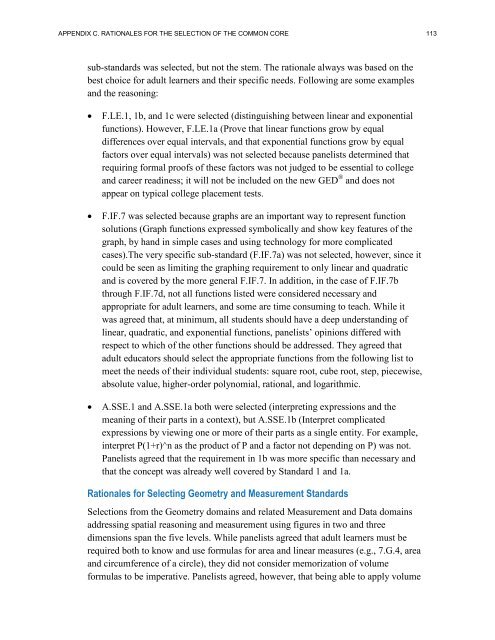CCRStandardsAdultEd
You also want an ePaper? Increase the reach of your titles
YUMPU automatically turns print PDFs into web optimized ePapers that Google loves.
APPENDIX C. RATIONALES FOR THE SELECTION OF THE COMMON CORE 113<br />
sub-standards was selected, but not the stem. The rationale always was based on the<br />
best choice for adult learners and their specific needs. Following are some examples<br />
and the reasoning:<br />
• F.LE.1, 1b, and 1c were selected (distinguishing between linear and exponential<br />
functions). However, F.LE.1a (Prove that linear functions grow by equal<br />
differences over equal intervals, and that exponential functions grow by equal<br />
factors over equal intervals) was not selected because panelists determined that<br />
requiring formal proofs of these factors was not judged to be essential to college<br />
and career readiness; it will not be included on the new GED ® and does not<br />
appear on typical college placement tests.<br />
• F.IF.7 was selected because graphs are an important way to represent function<br />
solutions (Graph functions expressed symbolically and show key features of the<br />
graph, by hand in simple cases and using technology for more complicated<br />
cases).The very specific sub-standard (F.IF.7a) was not selected, however, since it<br />
could be seen as limiting the graphing requirement to only linear and quadratic<br />
and is covered by the more general F.IF.7. In addition, in the case of F.IF.7b<br />
through F.IF.7d, not all functions listed were considered necessary and<br />
appropriate for adult learners, and some are time consuming to teach. While it<br />
was agreed that, at minimum, all students should have a deep understanding of<br />
linear, quadratic, and exponential functions, panelists’ opinions differed with<br />
respect to which of the other functions should be addressed. They agreed that<br />
adult educators should select the appropriate functions from the following list to<br />
meet the needs of their individual students: square root, cube root, step, piecewise,<br />
absolute value, higher-order polynomial, rational, and logarithmic.<br />
• A.SSE.1 and A.SSE.1a both were selected (interpreting expressions and the<br />
meaning of their parts in a context), but A.SSE.1b (Interpret complicated<br />
expressions by viewing one or more of their parts as a single entity. For example,<br />
interpret P(1+r)^n as the product of P and a factor not depending on P) was not.<br />
Panelists agreed that the requirement in 1b was more specific than necessary and<br />
that the concept was already well covered by Standard 1 and 1a.<br />
Rationales for Selecting Geometry and Measurement Standards<br />
Selections from the Geometry domains and related Measurement and Data domains<br />
addressing spatial reasoning and measurement using figures in two and three<br />
dimensions span the five levels. While panelists agreed that adult learners must be<br />
required both to know and use formulas for area and linear measures (e.g., 7.G.4, area<br />
and circumference of a circle), they did not consider memorization of volume<br />
formulas to be imperative. Panelists agreed, however, that being able to apply volume


